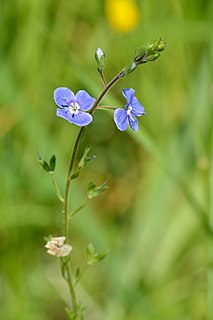
Veronica sect. Hebe is a group of plants within the genus Veronica, native to New Zealand, Rapa in French Polynesia, the Falkland Islands and South America. It was formerly treated as the separate genus Hebe. It includes about 90 species. Almost all species occur in New Zealand, apart from Veronica rapensis and Veronica salicifolia, found in South America. It is named after the Greek goddess of youth, Hebe. Informally, species in the section may be called shrubby veronicas or hebes.

Rakiura National Park is a nature reserve park located on Stewart Island / Rakiura, New Zealand. It is the newest national park of New Zealand and opened in 2002. The protected area covers about 85% of the island.

Xeronema is a genus of flowering plants containing two species, Xeronema moorei from New Caledonia, and Xeronema callistemon from the Poor Knights Islands and Taranga Island in New Zealand. The plants are herbaceous monocots, spreading by rhizomes, and have large flowers set on terminal spikes, with stamens towering above the flowers.

Veronica is the largest genus in the flowering plant family Plantaginaceae, with about 500 species. It was formerly classified in the family Scrophulariaceae. Common names include speedwell, bird's eye, and gypsyweed.

Veronica ochracea, synonym Hebe ochracea, is an ornamental plant of the family Plantaginaceae, which is endemic to the south island of New Zealand. Hardy to USDA climate zones 7–8 at least, protect aerial plant parts from severe frosts like any other hebe.

Veronica traversii, synonym Hebe traversii, is an ornamental plant of the family Plantaginaceae. It is endemic to the south island of New Zealand. The specific epithet traversii is in honor of naturalist Henry H. Travers (1844-1928), son of William Thomas Locke Travers.

Melicytus is a genus of flowering plants in the family Violaceae. Hymenanthera is a synonym.

Veronica breviracemosa, synonym Hebe breviracemosa, is a plant in the hebe group of the family Plantaginaceae native to Raoul Island of New Zealand's Kermadec Islands, where it is found in coastal cliffs and headlands.
The New Zealand Plant Conservation Network (NZPCN) is a non-governmental organisation devoted to the protection and restoration of New Zealand's indigenous plant life, including vascular plants, mosses, liverworts, hornworts and lichens.

Veronica hulkeana, synonym Hebe hulkeana, the New Zealand lilac, is a species of plant in the Plantaginaceae. Its pale mauve flowers are on long sprays, which develop from the tips of the branches. The dainty flowers, which occur in profusion, last from October until December. The foliage is dark green and shiny. The leaves are elliptic to obtuse in shape and are 7–10 cm long and 2–3 cm wide. This cold-hardy plant is easy to grow, providing it has well drained, light soil and an open, sunny position. Its natural habitat is in dry rocky places in the northern part of the South Island up to an altitude of 900 m.

Veronica stricta, synonym Hebe stricta, commonly called koromiko, is a flowering plant in the family Plantaginaceae, which is endemic to New Zealand.

Veronica odora, known as the boxwood hebe, mountain-box, Hebe odora or Hebe buxifolia, is a plant in the family Plantaginaceae, and it is native to New Zealand. Veronica odora was discovered on the Auckland Islands by J.D Hooker in 1840. A certain amount of confusion later arose following its collection on mainland New Zealand by Ernst Dieffenbach and its naming as Veronica buxifolia by George Bentham. Even overseas, Veronica odora is still not infrequently known as Veronica buxifolia.

Veronica pimeleoides, synonym Hebe pimeleoides, is a flowering plant of the family Plantaginaceae. It is endemic to the dry mountains of Marlborough and Canterbury, in South Island of New Zealand. It is a low-growing, evergreen shrub, reaching 60 cm in height, with grey-green, spear-shaped leaves that are 7–10 mm long. Flowers are pale lilac.

Veronica salicifolia, synonym Hebe salicifolia, the koromiko, or willow-leaf hebe, is a flowering plant in the family Plantaginaceae, which is found throughout the South Island of New Zealand and in Chile. It is a large, evergreen shrub, reaching 2 m in height, with light-green, spear-shaped leaves that are up to 12 cm long, and white or pale lilac flowers.

Veronica tetragona, synonym Hebe tetragona, is a subalpine plant of the family Plantaginaceae, which is endemic to New Zealand.

Veronica pauciramosa, synonym Hebe pauciramosa, is a species of plant in the family Plantaginaceae, endemic to the South Island of New Zealand, where it grows in mountains. It is an upright, evergreen shrub about 16 in (40 cm) tall, with green, spear-shaped leaves 0.2 in (6 mm) long, and white flowers.
Althenia bilocularis is a plant found in both Australia and New Zealand, in fresh to brackish waters. In Australia it is found in all mainland states with the exception of the Northern Territory. In New Zealand it is found on the North, South and Chatham Islands.
Pimelea traversii is a species of shrub in the family Thymelaeaceae. It is native to New Zealand. The specific epithet traversii is in honor of naturalist Henry H. Travers (1844-1928), son of William Thomas Locke Travers.

Veronica jovellanoides, commonly known as Riverhead speedwell, is a threatened flowering plant in the family Plantaginaceae. Endemic to New Zealand, only three plants are known in the wild. All are found within the Ernest Morgan Reserve, a 20 ha forest northwest of Auckland. Its discovery is accredited to a retired plant nursery owner, Geoff Davidson, who organised the land's protection a few decades prior, and found it by chance on a walk in November 2007.

Veronica obtusata, the northern hebe, is a flowering plant belonging to the family Plantaginaceae. It is native to northern New Zealand, and was first described by Thomas Cheeseman in 1916.
















